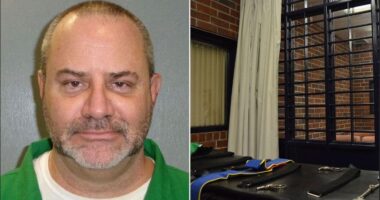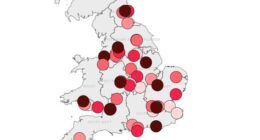CHICAGO (WLS) — Recent reports are showing a decrease in violent crime rates nationwide, with early data from the federal government indicating a substantial decline in many cities across the United States.
Mayor Brandon Johnson just this week credited his administration for the decline in Chicago.
Many entities are lining up to take credit for the decrease, which may well prove to be a combination of many factors.
About a year ago, Chicago introduced an enhanced effort to combat gun violence. Various local, state, and federal agencies involved in this joint effort are pleased with the progress made so far. They believe that their collaborative approach is contributing to the positive trend in reducing crime rates.
The expansion of the Crime Gun Intelligence Center (CGIC) has strengthened the partnership among over a dozen agencies dedicated to preventing and solving gun-related crimes. The ABC7 I-Team recently had the opportunity to speak with authorities at Chicago’s CGIC to discuss the advancements made by the center.
ABC7 Chicago is now streaming 24/7. Click here to watch
“CGIC brings together 13 partner agencies into one location with one goal, which is reducing violent crime here in the city of Chicago and beyond. And we’ve been able to achieve that in the first year,” said Christopher Amon, the Special Agent in Charge for ATF-Chicago.
Amon worked with the Chicago Police Department and other agencies to expand the intelligence center where agents, cops, detectives, deputies and prosecutors are able to gather under one roof to focus on real-time firearms and ballistics tracing, which includes analyzing gun shell casings left behind, much like tracing a fingerprint.
Gun investigations that begin on the street will end up on being plotted on the center’s firearm heat zone map to help experts as they work to review key evidence where guns were used and where people were killed or wounded.
“It’s changed everything having everybody embedded in one center,” said Antoinette Ursitti, Chief of Detectives for the Chicago Police Department.
Cutting-edge technology is fed into a national database to help develop and pursue leads using an interconnected ballistics network.
“So if you’re able to know that a recovered gun was used in a shooting 48 hours early, you’re going to have a better chance of solving that shooting,” Amon said. “You’re also going to have a better chance of prosecution on the individual caught with the gun.”
We had over 1,800 non-fatal shootings last year, and it’s one of our main focuses… We’re getting intelligence from the CGIC back to those detectives who are focusing on them, and we’re seeing significant improvements.
Kevin Bruno, CPD Deputy Chief of Detectives
One goal of the collaborative effort is to track down robbery crews or other repeat offenders.
In 2024, armed robbery suspects targeted the Irish Nobleman Pub in West Town the brazen crime caught on security cameras. Federal authorities recently indicted a fourth suspect, alleging the crew is responsible for robbing multiple liquor stores, convenience stores and bars in Chicago in 2023 through 2024. According to the indictment, in some cases, the masked group used firearms converted into machine guns.
CGIC is credited with helping to nab the suspects, who have pleaded not guilty to the charges.
“Previously that could have taken six months to a year to obtain those critical leads that we’re able to connect the dots in those robberies,” Amon said. “What we’ve seen in one year of operation… 200 tier one lead, meaning the lead is going to help with your investigation and potentially help solve that case.”
Kevin Bruno, the Deputy Chief of Detectives for the Chicago Police Department, told the I-Team one of the big differences they are seeing with CGIC is the timeliness with getting information and intelligence back to the detectives to help bolster their cases.
“We had over 1,800 non-fatal shootings last year, and it’s one of our main focuses. This year, we’re up to 58 dedicated detectives focusing on non-fatal shootings,” Bruno said. “We’re getting intelligence from the CGIC back to those detectives who are focusing on them, and we’re seeing significant improvements.”
The lack of arrests in non-fatal shootings has plagued the Chicago Police Department for years. CPD said those numbers are now improving.
The department provided the I-Team with their non-fatal clearance numbers from January to May over four years. This year, CPD solved more than twice as many cases as it did during the same time frame in 2022, which is a dramatic jump. This includes cases cleared by exceptional means, which can include a suspect’s death or prosecutors declining to file charges.
The I-Team was also given an inside look into CPD’s rarely-seen Forensic Firearms Lab, where officials credit enhancements in basic ballistics work along with advanced technology for improving outcomes. That lab provides intel on guns and shell casings to the CGIC.
Chief Ursitti said the center is at the heart of a lot of positive progress in both the reduction of violent crime incidents as much as an increase in clearance rates.
“You’re going to see that firearms can be used anywhere, not just in the city, but in the country,” Ursitti said. “That’s what’s so vital about the partnership that we have here with the ATF and our other partners (butt) to ultimately put together the big picture of not only the story of that weapon, but the people who came in contact with that weapon.”
Amon emphasized he is proud of the results so far but said there is still a lot of work to do to continue driving down crime even further in 2025.
“There’s 2,300, approximately, shooting events in the city. There’s not 2,300 different shooters,” Amon said. “So what the evidence shows us from the CGIC, it’s clear that there’s a small subset of individuals responsible for the majority of the shootings, and that’s what we see, that 21% of the firearms that are linked to other shootings helps us focus and narrow our focus on the most violent.”
There are dozens of Crime Gun Intelligence Centers across the country, and while there is promising evidence, some crime experts say more research is needed to definitively prove a link to lower rates of gun violence.
Copyright © 2025 WLS-TV. All Rights Reserved.

















